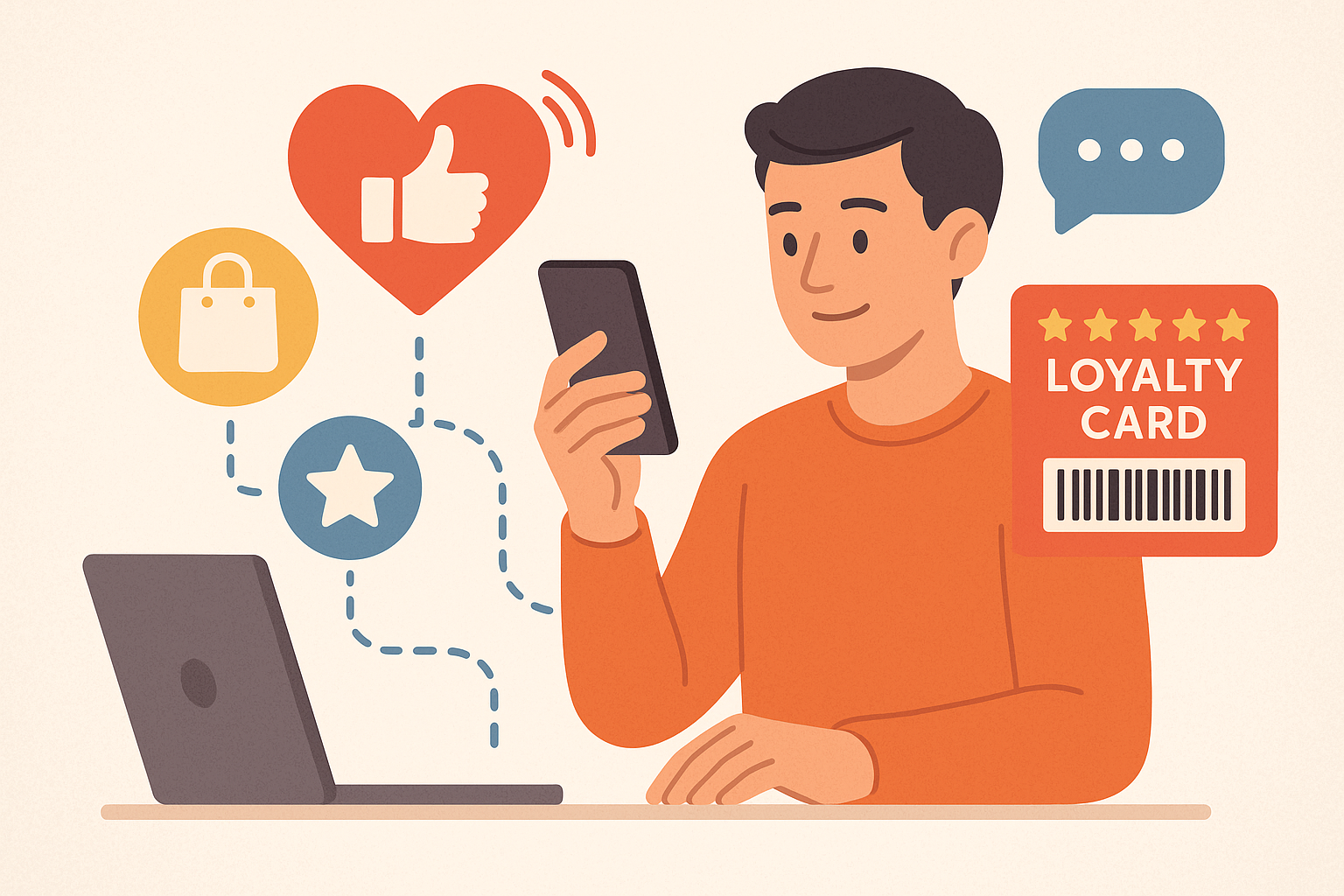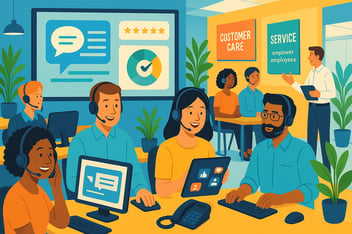
In today's fast-paced digital world, building customer loyalty is more important than ever. With so many options available to consumers, businesses need to go above and beyond to keep customers coming back. In this blog post, we will discuss seven strategies for building customer loyalty in the digital age, as well as how to create a winning customer experience in 2025 and beyond.
The Importance of Customer Loyalty
Customer loyalty is crucial for the success of any business. Not only does it lead to repeat purchases, but loyal customers are also more likely to recommend your brand to others, acting as authentic advocates who share positive experiences within their personal and professional networks. In fact, studies have shown that acquiring a new customer can cost five times more than retaining an existing one—highlighting the significance of investing in lasting relationships rather than focusing solely on acquisition. Moreover, loyal customers are often more receptive to new offerings, are quicker to forgive a rare misstep, and provide candid feedback that can drive meaningful improvements. In an era where consumers are bombarded with choices, loyalty brings stability and helps reduce churn. Therefore, it is essential for businesses to focus on building strong relationships with their customers, ensuring every touchpoint—from service interactions to tailored communications—reflects trust, value, and genuine care.
1. Personalize the Customer Experience
One of the best ways to build customer loyalty is by personalizing the customer experience. Today’s consumers expect brands to recognize their preferences, anticipate their needs, and deliver relevant interactions at every touchpoint. By collecting data on your customers' preferences and behaviors—such as purchase history, browsing patterns, and communication preferences—you can tailor your marketing efforts to meet their individual needs and interests. Whether it's through personalized emails that reference past purchases, targeted ads that align with a customer’s browsing habits, or customized product recommendations based on recent activity, thoughtful personalization demonstrates to customers that you value their business as individuals rather than just transactions. Beyond marketing, personalization can extend to service channels, loyalty rewards, and even post-purchase follow-ups, creating a seamless and memorable journey that keeps customers engaged. When done well, a personalized experience fosters trust, increases satisfaction, and encourages long-term loyalty by making each customer feel seen, understood, and appreciated.
2. Provide Excellent Customer Service
Customer service is another key factor in building customer loyalty. Customers want to know that they can trust your brand to address any issues or concerns they may have, and that their questions will be met with timely, respectful, and effective support. Responsive customer service is not just about resolving problems—it’s about creating a positive, memorable experience every time a customer reaches out, whether through live chat, email, phone, or social media. Empower your support teams with the right training, technology, and autonomy to make quick decisions, and always follow up to ensure resolution meets or exceeds expectations. Proactively communicate about delays or challenges, and use every interaction as an opportunity to build rapport and demonstrate that your business truly listens and cares. By providing excellent customer service, you can show customers that you care about their experience and are willing to go the extra mile to ensure their satisfaction, which builds lasting trust and encourages customers to return, recommend, and engage long-term.
3. Reward Loyal Customers
Another effective strategy for building customer loyalty is to reward loyal customers. Creating a structured loyalty program, such as a points-based system, tiered membership, or referral rewards, gives customers tangible and emotional incentives to choose your brand again and again. Exclusive discounts, early access to new products, and special offers—tailored to each customer’s preferences—can make loyal patrons feel truly valued and recognized for their ongoing support. Go beyond transactional rewards by acknowledging key milestones, like anniversaries or birthdays, with personalized notes or gifts. Consider featuring loyal customers in your community or sharing their stories on your platforms, further deepening the relationship and showing authentic appreciation. These loyalty-building efforts don’t just encourage repeat purchases; they help transform satisfied customers into enthusiastic brand advocates, strengthening your brand’s reputation in the market and cultivating a community that chooses you time after time. By showing customers that their loyalty is valued at every stage, you can strengthen the relationship, foster emotional connection, and encourage long-term loyalty that drives your business’s growth.
4. Engage with Customers on Social Media
In the digital age, social media plays a significant role in building customer loyalty. These platforms provide unique opportunities for brands to interact with customers in real time, foster a sense of belonging, and deliver value that extends beyond simple transactions. By engaging with customers on platforms like Facebook, Instagram, and Twitter, you can create a sense of community and keep customers connected to your brand, making your business part of their daily digital experience.
Actively responding to comments and messages demonstrates that you listen and care, while sharing user-generated content—such as testimonials, photos, or stories featuring your products—recognizes your loyal customers and encourages others to participate. Running social media contests, Q&As, and live sessions not only boosts engagement but also gives your audience a voice in your brand’s story. Transparency in communication, authentic storytelling, and regular updates about new services or products help build trust and keep your brand top of mind.
Furthermore, leveraging insights from social interactions allows you to anticipate trends, adapt your offerings, and address concerns quickly, all of which reinforce a customer-centric culture. Ultimately, effective social media engagement transforms casual followers into passionate brand ambassadors, strengthening loyalty and creating a competitive edge in a crowded digital landscape.
5. Offer Seamless Omnichannel Experiences
With the rise of online shopping, it's essential for businesses to offer seamless omnichannel experiences. Today’s customers expect to interact fluidly with your brand no matter where they are—whether they’re shopping on your website, browsing on their mobile device, scrolling through social media, visiting a brick-and-mortar location, or contacting customer support via chat or phone. They want every channel to be interconnected, so they can start a shopping journey on one platform and pick it up easily on another without losing context or continuity.
A successful omnichannel strategy ensures that product availability, pricing, and promotions are consistent everywhere, and that customer profiles, preferences, and order histories are accessible across all touchpoints. This level of integration allows customers to move effortlessly between online carts, wish lists, in-store pickups, and loyalty programs, creating a truly unified experience. Features like buy-online-pickup-in-store (BOPIS), digital receipts, and support for multiple payment options also illustrate your commitment to meeting customers where they are.
By providing a consistent experience across all touchpoints, you can build trust with customers, showcase a customer-centric approach, and make it easier for them to engage with your brand in the ways that suit them best. Ultimately, seamless omnichannel experiences not only increase satisfaction and convenience for your customers, but also drive retention and brand advocacy in a competitive, digitally driven marketplace.
6. Collect and Act on Customer Feedback
Actively listening to your customers is fundamental to earning and maintaining their loyalty. Gathering feedback through surveys, reviews, and social channels allows you to tap into your customers’ experiences, preferences, and unmet needs. By analyzing this input, you gain valuable insights that can inform everything from product development to customer service improvements. Most importantly, taking concrete actions based on what you learn—like addressing recurring issues, implementing popular suggestions, or publicly acknowledging feedback—demonstrates that you value your customers’ voices and are committed to enhancing their experience. This collaborative approach not only builds trust, but also empowers customers to feel invested in your brand’s growth and success.
7. Stay Ahead of the Curve
To create a winning customer experience in 2025 and beyond, businesses need to stay ahead of the curve. This means keeping up with the latest technology trends, understanding changing consumer behaviors, and adapting to new challenges. By continuously innovating and evolving, you can ensure that your brand remains relevant and continues to build customer loyalty in the digital age.
In conclusion, building customer loyalty in the digital age requires a combination of personalized experiences, excellent customer service, and engaging with customers on social media. By rewarding loyal customers, offering seamless omnichannel experiences, and collecting and acting on customer feedback, businesses can create a strong foundation for long-term success. To create a winning customer experience in 2025 and beyond, it's essential for businesses to stay ahead of the curve and continuously innovate to meet the changing needs of customers. Start implementing these strategies today to build lasting relationships with your customers and drive success for your business.




